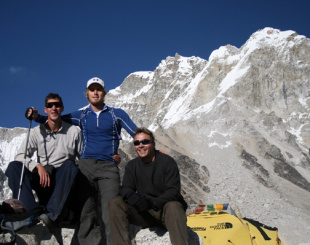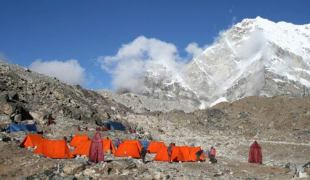Hitting sixes on Everest
Nick Compton on his experiences with a group of 18 amateur and professional cricketers on Mount Everest
Nick Compton
25-Nov-2007
Some players choose to toil in the gym during their winters. Others put their feet up. Nick Compton and Graham Napier chose an entirely different option, joining a group of 18 amateur and professional cricketers at Mount Everest a few weeks ago. Their aim? To stage the world's highest cricket match and raise money for the PCA Benevolent Fund.
|
|

|
Mount Everest is not a place you would normally associate with a game of cricket. Having now played one up there, I can see why.
The Professional Cricketers' Association (PCA) had organised a trek from Kathmandu to Everest Base Camp as a fundraiser for the PCA Benevolent Fund. Our group consisted of five professional cricketers and 12 other men and women who are connected to the sport in some way. We had included in our kit a "Kwik-cricket" set with a few bats and balls. The match we played on our last day was a great way to connect with the locals, illustrating how sport can bring together people from all lifestyles. The sherpas had been carrying our bags and had been at our service for the duration of trip. Once we entered the cricket domain, all that was forgotten. Sherpas v PCA could have been England v Australia at Lord's.
We played in what looked like a big crater. It was dusty and not dissimilar to some subcontinental wickets. The sherpas batted first and ran an impressive number of quick singles. The PCA, blaming nausea and exhaustion for our lack of running between the wickets, were relieved when Essex's Graham Napier hit the winning boundary. It was a great way to end our trip.
But first, before we even played our game of cricket on top of the world, we had to reach Base Camp. That first glimpse of Mount Everest was a bit like scoring that breakthrough hundred you wait a long time for. The colossal tower of rock and earth reaching almost 9000 metres into Nepalese air is a magical sight and one I will savour for a time to come. Even after two weeks of constant nausea, a headache that felt like a thousand bulls charging through my skull, and legs of jelly, I still would not have swapped the experience for anything.
When I embarked on the journey, I never in my wildest dreams expected it to be so tough. The breathtaking views and the experience of camping for two weeks in the Himalayas, home to the three tallest mountains in the world, were at the forefront of my mind. What followed would be a great lesson in both respect and humility.
We left Kathmandu in a small 17-seater aircraft that swirled high into turbulence before it dive-bombed onto the side of a small runway cut into the mountainside. Despite having left half my stomach in the plane, I began to experience real excitement. The lush green mountainside with snow-covered peaks in the distance and the cool, thin, fresh air were a welcome reprieve from smoggy London.
|
|

|
At first we simply absorbed our surroundings, chatted to locals and got to know the rest of the group. I was also keen to learn more about photography. Napier, my tent mate, was already an enthusiast, so I badgered him most of the time - I still cannot work out why he always wanted to walk on his own! The enigmatic landscapes were a photographer's dream. Huge, snow-covered mountains, glittering glaciers, and sinuous rivers all had me snapping away at every available opportunity in search of the one shot that would propel me to National Geographic stardom. Soon my memory cards were running low, and once I realised that the mountain wasn't going anywhere, I calmed down.
As conditions worsened, the landscape turned from mountain green to something resembling the moon. The air got thinner and our steps heavier: soon I was counting each one and resting after every 50. Our focus had shifted to what mattered most, simply walking and breathing, activities one usually takes for granted. When survival mode really kicked in, I could draw parallels with the people the PCA Benevolent Fund helps. This is what some of them have to contend with on a daily basis. The Fund assists those cricketers whose careers and lives have been shattered, be it in an accident or through illness. That realisation helped propel my consciousness away from myself.
Higher up, our energy levels dropped and the priority became simply getting to the next camp. The fluctuations in temperature gripped us. As soon as the sun went behind a mountain, it became incredibly cold. At around 4 pm, we would be pulling on thermals, beanies and protective gear, preparing ourselves for a long and freezing night. There were no camp-fires to huddle around; the warmth came from a cup of the local brew and some conversation with my fellow trekkers.
Two of these were Adrian Morgan and Cameron King, who are the assistant groundsman and dressing-room attendant respectively, at Lord's. Before the trek, I would have exchanged little more than a friendly "Good morning" and a look at the wicket with "Morg". On this trip I discovered he had a keen interest in bird-watching and I suddenly found myself looking for Morg every time I saw a bird and relying on him to tell me what it was.
It was only once we got above 4000 metres that the effects of the altitude really become apparent. Before the trek a doctor had explained about altitude sickness, the symptoms and warning signs. As she ended the talk with a sinister "You might not wake up", it was hardly surprising that we got little sleep that night!
|
|

|
Regardless of fitness and training, once you enter the realms of Base Camp, altitude sickness can catch anyone. We were all affected in some way, and morale took a knock when Cameron had to be airlifted off the mountain just a day from Base Camp. When you entrench yourself as deeply as we did in nature, you realise everyone's equal up there. Nature has a way of bringing one back to earth. The pace of nature and its balance is something that become very apparent; you cannot escape it, nor do you want to. You needed to respect the enormity of the task and the conditions.
Amid the brutality of some very serious climbs, there was time to soak up the culture. The Nepalese people display a calm and contentment that is strengthened by their deep Buddhist beliefs. We came across Buddhist monuments and places of worship, which one has to walk around to the left of to show respect to the gods. Watching Sherpas carry packs of between 50 to 80kg on their backs up enormous mountains was a very vivid image - to the point where one of our trekkers asked, "Is that heavy?" You can imagine the reply, had they only spoken English! What for us would seem a harsh way of life is normality for them. It really put our incessant moaning in context.
The sight we had all been waiting for loomed ahead eventually. Everest has mysticism to it. Even at Base Camp only the peak is visible, as though to see it all you have to keep climbing. To think we were standing less than three km below the highest point in the world, looking at the route to the summit that so many had gone to, yet so many had failed to reach, was incredible. But I won't be suggesting to Middlesex that we should be practising our six-hitting up here for the pre-season training trip!
To donate to the PCA Benevolent Fund click here
Nick Compton is a middle-order batsman for Middlesex